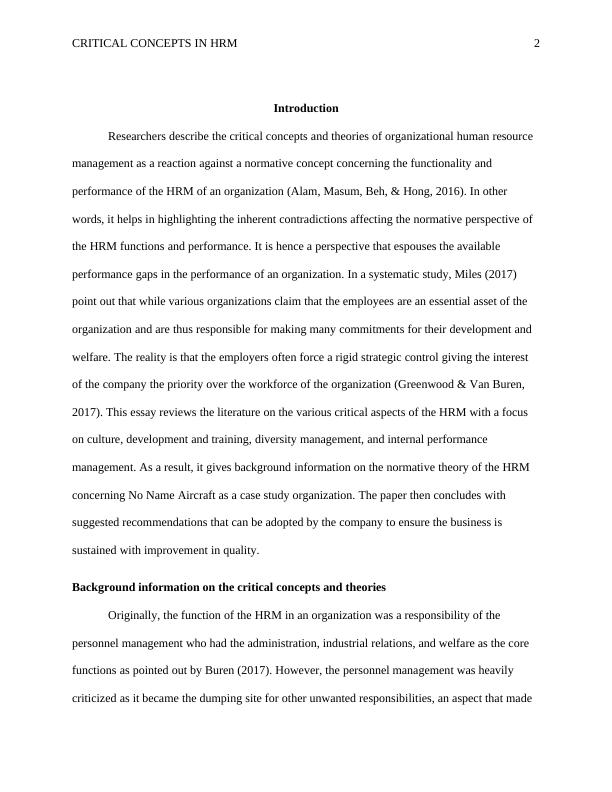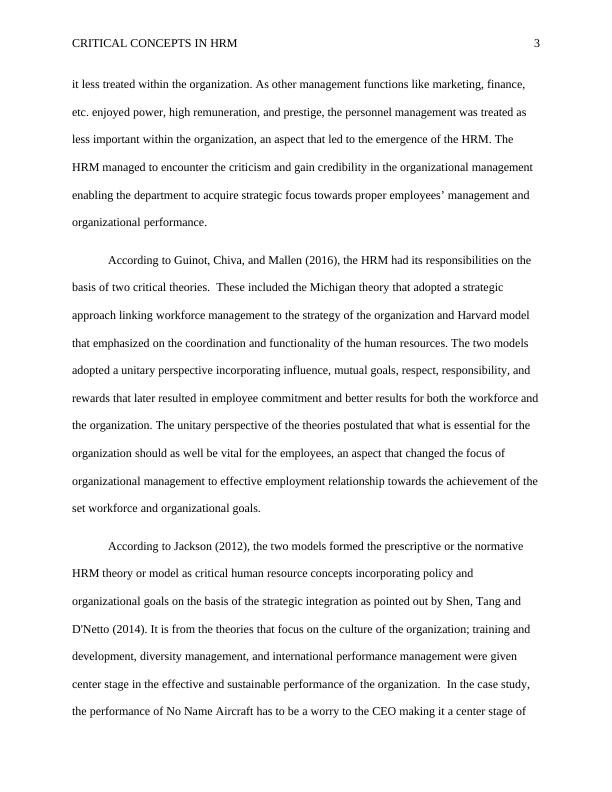BUSM3310 - Critical Concepts In HRM
Added on 2020-03-01
13 Pages3493 Words137 Views
Running head: CRITICAL CONCEPTS IN HRM Critical concepts and theories of Organisational HRMStudents’ NameAffiliate Institution

CRITICAL CONCEPTS IN HRM2IntroductionResearchers describe the critical concepts and theories of organizational human resource management as a reaction against a normative concept concerning the functionality and performance of the HRM of an organization (Alam, Masum, Beh, & Hong, 2016). In other words, it helps in highlighting the inherent contradictions affecting the normative perspective of the HRM functions and performance. It is hence a perspective that espouses the available performance gaps in the performance of an organization. In a systematic study, Miles (2017) point out that while various organizations claim that the employees are an essential asset of the organization and are thus responsible for making many commitments for their development and welfare. The reality is that the employers often force a rigid strategic control giving the interest of the company the priority over the workforce of the organization (Greenwood & Van Buren, 2017). This essay reviews the literature on the various critical aspects of the HRM with a focus on culture, development and training, diversity management, and internal performance management. As a result, it gives background information on the normative theory of the HRM concerning No Name Aircraft as a case study organization. The paper then concludes with suggested recommendations that can be adopted by the company to ensure the business is sustained with improvement in quality.Background information on the critical concepts and theoriesOriginally, the function of the HRM in an organization was a responsibility of the personnel management who had the administration, industrial relations, and welfare as the core functions as pointed out by Buren (2017). However, the personnel management was heavily criticized as it became the dumping site for other unwanted responsibilities, an aspect that made

CRITICAL CONCEPTS IN HRM3it less treated within the organization. As other management functions like marketing, finance, etc. enjoyed power, high remuneration, and prestige, the personnel management was treated as less important within the organization, an aspect that led to the emergence of the HRM. The HRM managed to encounter the criticism and gain credibility in the organizational management enabling the department to acquire strategic focus towards proper employees’ management and organizational performance. According to Guinot, Chiva, and Mallen (2016), the HRM had its responsibilities on the basis of two critical theories. These included the Michigan theory that adopted a strategic approach linking workforce management to the strategy of the organization and Harvard model that emphasized on the coordination and functionality of the human resources. The two models adopted a unitary perspective incorporating influence, mutual goals, respect, responsibility, and rewards that later resulted in employee commitment and better results for both the workforce andthe organization. The unitary perspective of the theories postulated that what is essential for the organization should as well be vital for the employees, an aspect that changed the focus of organizational management to effective employment relationship towards the achievement of theset workforce and organizational goals. According to Jackson (2012), the two models formed the prescriptive or the normative HRM theory or model as critical human resource concepts incorporating policy and organizational goals on the basis of the strategic integration as pointed out by Shen, Tang and D'Netto (2014). It is from the theories that focus on the culture of the organization; training and development, diversity management, and international performance management were given center stage in the effective and sustainable performance of the organization. In the case study, the performance of No Name Aircraft has to be a worry to the CEO making it a center stage of

CRITICAL CONCEPTS IN HRM4concern to the employees, the customers, and all other stakeholders of the company. It is in working together with all its subsidiaries in China, Vietnam, and Singapore that will help the organization not only to work towards maximizing the return to shareholders and in its investments but also increase the quality of production and benefit to the workforce. Culture Organizational culture is defined as a conceptual share of values and beliefs within an organization that helps in shaping the pattern of employees’ behavior within the organization. Greenwood and Van Buren (2017) define it as the driving force that organizes the contribution and effort of the members within an organization while providing a holistic understanding of what needs to be achieved and how it should be done. It also focuses on how goals are interrelated within an organization as well as how every employee can attain the goals. In other words, it is the manner in which an organization keeps its workforce in line with the set objectives. In a systematic study, Shen, Tang, and D'Netto (2014) point out that human resource management often has a very challenging responsibility in ensuring the organization adopts a culture that is beneficial to both the employees and the business. It is the full responsibility of the HRM to employ the qualified personnel, help them to embrace the organizational culture with an aim developing their professional abilities for the benefit of the organization (Stone, 2016). For instance, it is the responsibility of O’Meara to ensure that the HR departments in all the subsidiaries of the company in Singapore, China, and Vietnam work towards achieving the set employment objectives that meet the employment policies within their location. In other words, the act of avoiding persons living with disability in China is against the law, an aspect that can cause the company dearly when it comes to the

End of preview
Want to access all the pages? Upload your documents or become a member.
Related Documents
Strategic Management in Sainsbury : Reportlg...
|18
|6485
|225
Differentiating between Personnel and Human Resource Management Approacheslg...
|21
|2648
|195
Human Resource Management Sample Assignmentlg...
|20
|4250
|67
Human Resource Management: Strategic HRM Models, Organizational Levers, and Job Design Strategies of TESCO Ltdlg...
|13
|3922
|376
Managing human resources - Assignmentlg...
|12
|4503
|173
Managing Human Resource Rephrasinglg...
|13
|4198
|108
